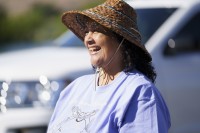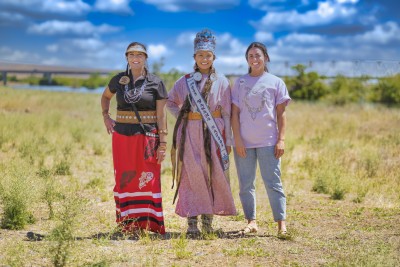Hanford Cleanup Champions
An Interview with Yakama Nation’s Hanford Cleanup Team
Last summer, the Hanford Journey returned after a two-year hiatus. Nearly 200 people gathered along the Columbia River, upstream from the Hanford Nuclear Site, to celebrate resiliency and hope for a thorough cleanup. Columbia Riverkeeper’s Simone Anter spoke with Yakama Nation’s Environmental Restoration Waste Management (ERWM) program staff about their experiences co-planning the Journey—and why Hanford is a place worth fighting for.
What was your favorite memory of last year’s Hanford Journey?

Photo credit: Sky Bear Media
Laurene Contreras, ERWM Program Director: That’s hard to answer but I really enjoyed the night before the event kick-off, when the canoe family came in. [The night before the Journey, ERWM and Columbia Riverkeeper hosted a dinner at the Legends Casino to ground the upcoming event, and share stories and food.] We heard from Yakama Nation Tribal Government, ERWM, Columbia Riverkeeper staff, and our guests of honor, the Puyallup Canoe Family. Overall, I also really enjoyed the activities throughout the day and it was really neat to get out on the water and enjoy the scenery. It reminded me of Atwai Russell Jim [the founder of ERWM and a renowned advocate for Hanford cleanup], and what he always said, “It’s not what you see but what you don’t see.” When you are out there, you see the beauty of the area but not the pollution. But that pollution, it’s real. It’s surreal when you are impacted by that thought that the pollution is right there and not going away. That’s why it’s so important to have these events to remind our people that these are our lands and we are not going anywhere.
What is one current cleanup challenge at Hanford everyone should know about?
McClure Tosch, ERWM Technical Staff: The fact that we are getting final Records of Decisions (RODs) in the River Corridor does not mean that the River Corridor is cleaned up, it just means that the actions to be taken have been finalized in the federal government’s eyes. [A ROD is a public document that explains the remediation cleanup plan at a Superfund site.] There is still an opportunity under the federal cleanup process to get more cleanup if those actions in the ROD don’t meet the criteria, or the timeline doesn’t meet the proposed plan. I want everyone to understand that and continue to push the Tri-Parties [the U.S. Dept. of Energy, U.S. Environmental Protection Agency, and Washington Dept. of Ecology] to make sure these cleanups are protective of human health and the environment.
What is ERWM’s role in the Hanford cleanup?
Rose Ferri, ERWM Technical Staff: I would sum it up in one word: compliance. There’s this ideology that it’s the federal government’s responsibility for cleanup, so they follow federal laws. But that’s not really true in all cases. Laws are written with a certain amount of ambiguity and they are subject to interpretation. The federal government has its interpretation and we have ours, so we deal with that all the time. We also deal with outright noncompliance with the law. We have seen this with cultural resources under the National Historic Preservation Act. So our role in reviewing documents and cleanup plans related to Hanford is to make sure the federal government is in compliance, that they are using the best science and answering the right questions.
Can you explain the significance of the Hanford area to Yakama Nation?
Trina Sherwood, Cultural Specialist at ERWM: Our Ancestral lands of the Yakama Nation lie within the Hanford Site. Our Tribal members are the ongoing and upcoming stewards of these lands due to our connection to the cultural landscapes and resources that define and embody our heart, mind, and soul. Our elders have long established through our unwritten laws that we must embrace our intricate relationship with the living culture of animals, sacred foods/medicines and the Creator who blessed us with these and our breath of life. Creator showed us our “way of life” through life/death experiences of our people to continue our language, songs, and gathering our foods/resources through ceremonial teachings handed down since time immemorial. This is our “Circle of Life” to instill in our youth the importance of their role in their Tribe, family, and communities. Our reserved rights in the Treaty of 1855 have been violated by the contamination of our ceded lands.

Ellia-Lee Jim, Miss Yakama Nation ‘22-’23; and Columbia Riverkeeper Staff Attorney Simone Anter.
Photo credit: Sky Bear Media.
To ensure the complete and timely cleanup of the Hanford Nuclear Site, we review and critique cleanup and restoration plans.
The fight to clean up the most polluted place in America.
Add your voice to the growing number of people holding the U.S. government accountable for decades of nuclear-waste pollution.
Want to hear all the stories from Columbia Riverkeeper's Currents Issue 1, 2023 Newsletter?


